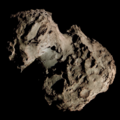C/1862 N1 (Schmidt)
| Discovery | |
|---|---|
| Discovered by | Johann Schmidt Wilhelm Tempel |
| Discovery site | Athens Observatory |
| Discovery date | 2 July 1862 |
| Designations | |
| Comet Schmidt–Tempel 1862 II[1] | |
| Orbital characteristics[2][3] | |
| Epoch | 4 July 1862 (JD 2401325.5) |
| Observation arc | 29 days |
| Number of observations | 72 |
| Aphelion | ~1,935 AU (inbound) |
| Perihelion | 0.981 AU |
| Semi-major axis | ~968 AU (inbound) |
| Eccentricity | 0.99898 (inbound) 1.00002 (outbound) |
| Orbital period | ~30,100 years (inbound) |
| Inclination | 172.11° |
| 328.44° | |
| Argument of periapsis | 27.166° |
| Mean anomaly | 359.25° |
| Last perihelion | 22 June 1862 |
| Physical characteristics[4] | |
| Comet total magnitude (M1) | 9.4 |
| 4–5 (1862 apparition) | |
C/1862 N1 (Schmidt), sometimes referred to as C/1862 N1 (Schmidt–Tempel), is a non-periodic comet discovered by Johann Friedrich Julius Schmidt on 2 July 1862.
Observational history
[edit]The comet was discovered on 2 July 1862 Johann Friedrich Julius Schmidt, then director of the National Observatory of Athens, and a few hours later was discovered by Wilhelm Tempel, at Marseille Observatory. The comet upon discovery was located in the constellation Cassiopeia and Schmidt described the comet as being tailless, with a coma 22 arcminutes across, and visible with the naked eye. Temple estimated its magnitude to be 4–5. Schmidt observed the comet again on July 4 and noted a tail half a degree long.[4]
The comet passed at a distance of 0.0982 AU (14.69 million km) from Earth on 4 July, making it the fourth closest known approach of a comet to Earth in the 19th century.[5] Consequently the comet moved away from both the Earth and the Sun, while brightening moonlight hampered observations. The comet was last observed with the naked eye on 7 July. The comet faded rapidly throughout the month and it was last observed on 31 July.[4]
Meteors
[edit]The comet has been tentatively associated with the weak meteor shower ζ Arietids, observed between 13 and 25 August. The minimum orbital intersection distance between the comet and Earth is 0.028 AU.[6][7]
References
[edit]- ^ "Comet Names and Designations". International Comet Quarterly. Retrieved 23 June 2025.
- ^ "Barycentric Osculating Orbital Elements for Comet C/1862 N1 (Schmidt) in epoch 1800 and 2200". JPL Horizons On-Line Ephemeris System. Jet Propulsion Laboratory. Retrieved 23 June 2025. (Solution using the Solar System's barycenter (Sun+Jupiter). Select Ephemeris Type:Elements and Center:@0)
- ^ "C/1862 N1 (Schmidt) – JPL Small-Body Database Lookup". ssd.jpl.nasa.gov. Jet Propulsion Laboratory. Retrieved 14 January 2025.
- ^ a b c G. W. Kronk (2003). Cometography: A Catalog of Comets. Vol. 2: 1800–1899. Cambridge University Press. pp. 305–307. ISBN 978-0-521-58505-7.
- ^ "NEO Earth Close Approaches". cneos.jpl.nasa.gov. Jet Propulsion Laboratory. Retrieved 14 January 2025.
- ^ B. A. Lindblad (1971). "A computerized stream search among 2401 photographic meteor orbits". Smithsonian Contributions to Astrophysics. 12: 14–24. Bibcode:1971SCoA...12...14L. doi:10.5479/si.00810231.12.14.
- ^ D. Šegon; P. Gural; Ž. Andreić; et al. (26–30 August 2013). The Meteoroids: A Parent Body Search across Several Video Meteor Databases. Proceedings of the Astronomical Conference. A.M. University, Poznań, Poland. pp. 251–262. Bibcode:2014me13.conf..251S.
External links
[edit]- C/1862 N1 at the JPL Small-Body Database


